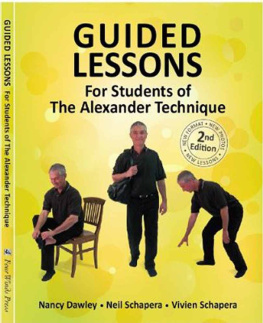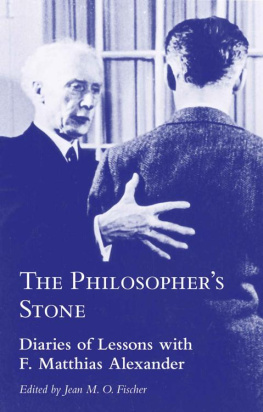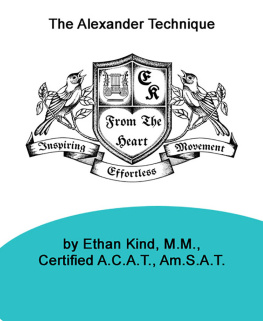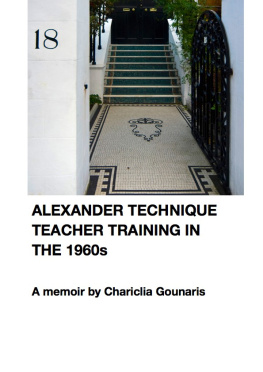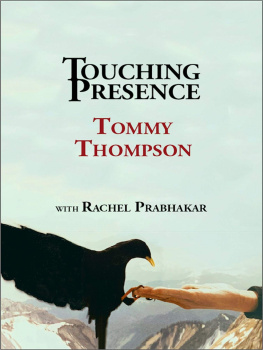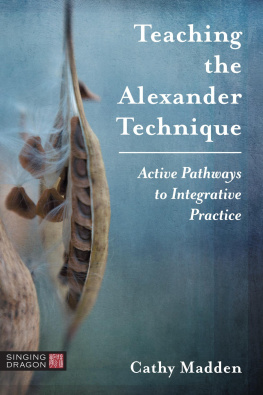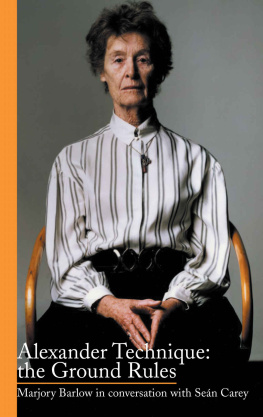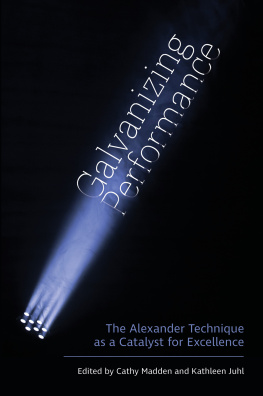GUIDED
LESSONS
For Students of
the Alexander Technique
Nancy Dawley Neil Schapera Vivien Schapera

Guided Lessons For Students of the Alexander Technique
(c) 2001 by Nancy Heisel Dawley
(c) 2010 by Nancy Dawley, Neil Schapera, Vivien Schapera
Published by:

FourWinds Press LLC
7445 Fourwinds Drive
Cincinnati, OH 45242
513.891.8062
Contact the Authors:
guidedlessons@gmail.com
First printing, second edition, September 2010
Printed in the United States of America
All rights reserved.
No part of this book may be reproduced or transmitted in any form or by any means, electronic or mechanical, including photocopying, recording, or by any information storage and retrieval system, without written permission from the authors.
Library of Congress Control Number 2010924189
Nancy Dawley, Neil Schapera, Vivien Schapera
Guided Lessons For Students of the Alexander Technique
ISBN10 0-9709809-6-5
ISBN13 978-0-9709809-6-0
1) Education
2) Health
3) Alexander Technique
Photography by:
Mary Beth Wilker, Wilker Design & Marketing
Book design by:
Mary Beth Wilker, Wilker Design & Marketing
www.wilkerdesign.com
For people everywhere interested in personal change.
Most of us know what we ought to do, but are sadly lacking in knowledge of how to do the means-whereby. F. M. Alexander

Nancy Dawley
Nancy graduated in 1999 from the Alexander Technique of Cincinnati Training Course, directed by Neil and Vivien. Her final year project ignited the spark for Guided Lessons and grew into the 1st edition, published in 2001. Nancy comes back together with her training course directors to create the 2nd edition.
Between lessons many students ask their teachers, How can I practice?
The purpose of this book is to assist your exploration of the Alexander Technique both with and without a teacher present. It provides simple activities for you to practice pausing, noticing, inhibiting, directing, and allowing.
You may want to work with your teacher until you understand the words and directions kinesthetically.
The guiding words in each lesson will help you avoid falling back into your habitual ways.
Think of Guided Lessons as multiple opportunities to explore your self. I envision a Lesson taking 5 or more minutes, depending on your schedule and interest. Each activity is merely a starting point. You choose the path from there. Lessons can be repeated yielding new insights and experiences each time.
Here are some further suggestions:
- Allow yourself a space of uninterrupted time, even if it is short.
- Read through the lesson and look at the pictures.
- Accept yourself where you currently are.
- Develop a specific intention for yourself.
- Pace yourself. There is no rush. If you have a time constraint, set an alarm clock so you can work without distraction.
Success is not completing a lesson correctly . It is following your intention, learning something about yourself, and allowing change during the process.
I hope you enjoy your Guided Lessons, and the new sense of self they generate.

Neil Schapera
Neil completed his Alexander training with Walter Carrington in London in 1987. Together with his wife Vivien, he has been training Alexander teachers in Cincinnati since 1993. Neil especially enjoys working with groups, and has given Alexander workshops for many years, including the Osher Lifelong Learning Institute at the University of Cincinnati.
Teaching the Alexander Technique has been the most satisfying and rewarding activity in my life. It is a joy to see students transforming themselves and being empowered to lead the lives they choose.
One of F. M. Alexanders books is entitled The Constructive Conscious Control of the Individual. Learning this skill is the key promise in the Alexander Technique. As you proceed through these lessons, you will in fact be learning to consciously control your life in a more constructive manner.
Learning to stop and not do what you would habitually do is the most important lesson you can learn here. Take as many opportunities as you can throughout the day to pause, to become aware of the choice you can exercise in how you do what you do. This will open the door to an entirely new way of living.

Vivien Schapera
Vivien was in the first group to train with Joyce Roberts in Cape Town, South Africa (1979). She completed her training at the Constructive Teaching Centre in London, with Walter and Dilys Carrington (1983). Vivien teaches regularly in New York, England and South Africa. At home in Cincinnati, she co-directs Alexander Technique of Cincinnati with Neil.
Of course it is best to experience the Alexander Technique by having one-on-one lessons with a qualified Alexander Teacher, but the reality is that the vast majority of people do not have access to a teacher.
Thinking is a great key to improving our lives. I can always tell when the trainees on our course, and my private students, have been reading about the Alexander Technique in their own time. Reading leads to thinking and the effects are astonishingly positive.
Furthermore, I have found that whilst there is no substitute for individual instruction, there is equally no substitute for practicing on ones own.
So here is a book that will help you think systematically about the Alexander Technique under three circumstances:
- If there is no teacher in your area, you can use this book to open the wonderful world of insights that the Alexander Technique has to offer.
- If you are a participant in group lessons, you can use this book to expand the experience and broaden and deepen your knowledge.
- If you are fortunate enough to have an Alexander Teacher, you can use this book to help you practice on your own, and also to help you formulate questions and requests.
I hope this book is a source of support and inspiration, and that if there is no Alexander Teacher where you live, you will become motivated to seek one out on your travels.
Table of Contents
Title
Introduction
Practical Applications
Essential Basics
Core Concepts
Technical Exploration
More Practical Applications
Appendix
... Man tends to become more and more a confirmed end-gainer, one who too often insists on gaining his end by any means, even at the risk of disaster, rather than take time to consider means whereby the end can be gained so as to ensure the best possible result. F. M. Alexander
What We Want:
Free = elastic, available, mobile
Up = lengthened and widened, aligned, released
What We Dont Want:
Fixed = stiff, held, immobile
Down = shortened, compressed, contracted
Two Kinds of Down:


Next page
